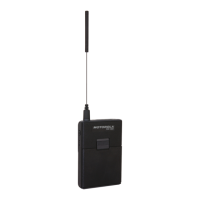Radio Permanent Disable
Permanent disabling is intended to protect a network from attack from a compromised or faulty radio. It can be used
when the radio has been compromised, or has been suspected of compromise for a long time. It is a one-way function
and no equivalent enable is available. Then the radio should be recovered and reprogrammed before being used again
by the service provider.
When the radio is permanently disabled, it becomes inoperable.
• All its security key material, that is GCK, GSKO, DMO SCKs, Ks, DCK, CCK, TMO SCKs are deleted.
• All its codeplug is deleted.
• All its software is deleted.
The permanent disable should be invoked when it has been determined that a radio is unrecoverable. When a radio
has been lost or stolen, the first step always is to stun the radio (using the temporary disable).
The permanent disable should be used with the deletion of the user radio record in the User Configuration Server and
the deletion of the K-REF association of the disabled radio in the Provisioning Centre and the Authentication Centre.
This deletion ensures that subscriber information is not downloaded into the Home Location Register if a restore of
the UCS is performed.
The system operator has to also ensure that the radio K-REF association is also removed from the other
Authentication Centres in the network, in cases where the K-REF pairs are duplicated across the network.
If this association is not removed, the radio could be assigned a new home zone that lies in a cluster where the K-REF
association has not been deleted.
Radio Permanent Disable and Radio Permanent Disable v2 are mutually exclusive selling features.
High Assurance Boot
The radio has a facility that ensures that the code and data flashed in the radio is authentic and has not been altered.
The hardware forces the HAB module to run at boot time. The module checks if all software comes from a trusted
source. The radio is checking the signature of the code and data segments present in the radio using a public/private
key mechanism.
If the HAB authentication of the flashed software fails, it does not allow the radio software to run.
Mobility Services
Following is the description of the Mobility Services.
Main Control Channel Frequencies
The radio can find a wide range of main control channels. The radio maintains stored lists of carrier frequencies
which are scanned in order.
1 A dynamic list of up to 32 discrete entries maintained only by the radio software.
2 A static list of up to 32 discrete frequencies specified by the operator that can be preprovisioned. The system
operator can modify this list using the programming tool.
3 A frequency range specification, using a specific offset, that can be preprogrammed in the factory. The system
operator can modify this range using the programming tool. Then the radio scans all frequencies in 25 kHz
intervals in the specified range.
4 An additional frequency range specification. Having two separate range specifications allows for two non-
contiguous blocks of frequencies or two different offsets.
Services and Features | 37
| | Send Feedback

